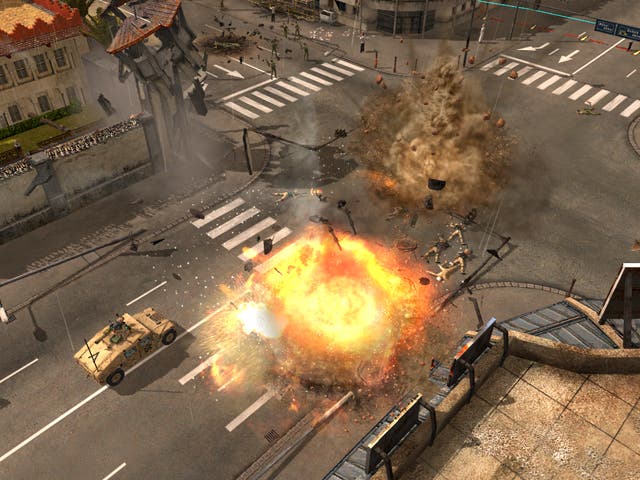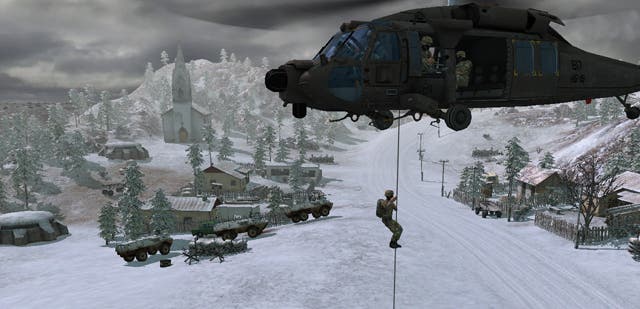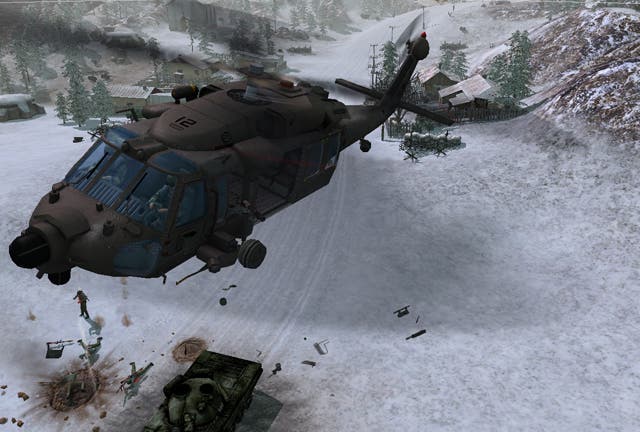Joint Task Force
E3: The world's first anti-war RTS?
Checkpoint charlies
Civilian vehicles can come in useful, too. Let's say you're on a mission that will send you behind enemy lines when you come across an old abandoned Mercedes. It'll carry up to five soldiers and, with a bit of luck, should make it easier for them to pass through checkpoints without being instantly recognised as enemy personnel. You can also use civilian vehicles to set up roadblocks - arranging them precisely how you want, as van Diemen explains.
"One of the frustrating things about RTS games is pathfinding, and we've tried to find a solution to that. You have the option to alt-click your units, and then you can manually control them with your cursor key. So if you want to set up roadblocks or form very specific formations, there's always a way to move every unit in the exact position that you want it."
That also goes for individual troops - and not only can you position them precisely, but you can issue direct commands, ordering a soldier to go prone, for example, or to attack a specific target using his secondary weapon. But your troops are also bright enough to use their own initiative - "So there is this micromanagement, but the AI is ready to take control."
You'll need to do all you can to protect your troops - not just for the obvious reasons, but because their individual skills develop with each objective completed. Each unit's progress is tracked and when one levels up, you have the option to either give them new skills or improve their existing abilities. Once they reach level four, you can promote them to what's called Hero status.
"Heroes are quite similar to the regular units, except they are more skilled," van Diemen says. "They can be taken not only from one mission to the next, as all the units can be, but from one campaign to the next."
Decisions, decisions

Don't go thinking you can just build up an entire army of heroes who will blast their way through the game, though - there are only a few hero slots available for each mission, and it's up to you to decide which type of hero will prove most useful. So, if you're looking at a mission which involves some tactical positioning but could end up in a right old bloodbath, you might like to pick a sniper hero and a medic hero, say. As the game progresses, the pool of heroes available to you will grow, and so will your options.
And there will be plenty of options available when it comes to multiplayer action, too. "You can play not only individual scenarios but the whole campaign co-operatively, with at least two players," says van Diemen. "We've managed to do it with four players," he adds - but so far, only two player co-op has been confirmed.
"For versus multiplayer, we don't have any fixed game modes, but instead we have what we call rules of engagement - a very extensive list of perameters that you can set to create your own game type. We have some presets, but you can create your own missions or your own multiplayer gameplay types.
"Furthermore, we're developing a matchmaking tool, so you can log onto our central server, meet people, chat with them, create smaller chat rooms, decide on game rules and then launch the multiplayer game from there."
Let's get physical

Whether you're going solo or playing with friends, or indeed random people off the Internet, you can expect super spanky graphics with lots of attention to detail - zoom in and you can even see exhaust fumes coming out of tailpipes and the like. In addition, van Diemen says, "We have AEGIA physics in the game, and we support both their software and their hardware solutions.
"So if you destroy a building, it will collapse dynamically; there's no fixed animation, it builds up from smaller parts and it will collapse dynamically depending on which side the attack is coming from and which weapon is used."
Then there are the weather effects, which will have a direct effect on gameplay - as van Diemen is keen to point out, "They're not just there as eye candy."
"So in the case of heavy rain, your visibility is much more limited, as is your hearing. When you're in the middle of the desert in Iraq or Afghanistan and there's a sandstorm, you can forget about air support; there's no recon information available, your movement is hindered, and your weapons are affected as well."

Of course, this isn't the first RTS game to feature weather effects which affect gameplay. Indeed, for all the new twists in JTF, there are plenty of elements which will be familiar to RTS fans - a fact which van Diemen is happy to admit.
"When we started developing the game, we had two goals. First of all, we wanted to stay true to the RTS genre as far as gameplay is concerned. So, anybody who considers himself or herself an RTS gamer would be familiar with the game mechanics, and would very quickly be able to jump into the game.
"On the other hand, we wanted to move on and make it next-generation. That sounds pretty standard, but we definitely wanted to move this RTS game in a much more tactical direction."
So there you have it - Joint Task Force is a next-gen RTS game that's designed to please fans of the genre, whilst taking it in a new direction and throwing in a little bit of politics, too. But will it succeed? And will it convince everyone who plays it to write a very strong letter to their MP about how war is bad and wrong? Roll on September, when JTF will hit the shops and we'll get the chance to find out...
